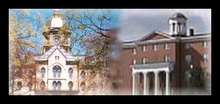I promised I would post more often. I should also promise to start reading my fellow blogger's blogs again too...
Last weekend I was away on tour with my choir. We sang in Des Moines and Omaha, which, to be painfully blunt, were probably the least exciting most populous cities of any states I've ever visited - and I've been to 34 of the 50 so far.
Nevertheless, my friends and I managed to have fun. In Des Moines three of us walked nearly the entire length of downtown from our hotel to the capital building around 9-11pm on Friday night. We seriously were the only people out and walking around the city. The city was dead and we must have looked very sketchy.
In Omaha I decided to pay a visit to the Joslyn Art Museum. It wasn't that bad of a place -actually, neither was Omaha really, in fact it seemed like there was a fair amount of historical interest in the city, I just didn't have the transportation or time to see it all. Back to the art museum...There was an exhibit on the St. John's Bible - the first illuminated manuscript commissioned in over 500 years.
This Bible is being produced for St. John's in Collegeville. For those of you not familiar with the abbey or university let me present this quote from their page describing the purpose of the St John's Bible:
"Saint John's Abbey and University are dedicated to ecumenism. The text, translation and imagery in The Saint John's Bible reflect this commitment."
Naturally, the manuscript does all it can to reflect this philosophy.
As a medievalist in training I found the style of the art work disappointing, but the concept very intriguing when compared to the Medieval manuscripts.
Anyway, I am going to be rather obnoxious and leave you all hanging by not delving into my thoughts and theories because speaking of manuscripts, I should be writing a paper right now on the Morgan Beatus. However, I do strongly suggest you all take a look at the St. John's Bible for yourselves.
Let me know what you think.
In the meantime I'll consider the possibility of eventually doing a doctorate in manuscript studies....mmm codicology....
Subscribe to:
Post Comments (Atom)









3 comments:
Yeah, it is sort of disappointing. I think its biggest problem is that it doesn't have a unified style of any sort. Some of the decoration is very traditional, some is very modern. The "flora and fauna" illustrations look like botanical drawings. It's a jarring effect and I think they would have done much better to pick a style and stick with it.
But then, I judge it all by the standards of the Book of Kells, and IMO, NOTHING can beat that for sheer perfection. :)
Yay! a real post.
I got to see the St. John's Bible about a year ago... (the day I met Matt, Sabitha, Emily, and Andy, in fact.) It was interesting, but your evaluation is pretty fair.
Hello: I am James Pepper and I have spent the last 18 years making a bible by hand and I have more illuminations in my set of Gospels than they have in their entire Bible. I was blessed by John Paul for this work. My web site is "The Pepper Bible" and there are videos of me at work from CBS and ABC and UMTV.
I wrote the Bible like a Book of Hours, where each page is decorated and I did it all by hand, without computers. Saint Johns claims they are the first to do this in 500 years, but the e Dallas Morning News interviewed them in 2001 comparing the two bibles so they know in print about other bibles when they make these wild claims. It's a shame too because there are a lot of bibles made in eh past 500 years and they should not be denying these people's faith in God!
Luke is a celtic insular manuscirpt with 25 carpetpages, and most of the verse initials are inhabited and the subject matter of the inhabited initial represents a letter fo the alphabet so I encoded the Apostles creed inot the decorations. Just to get even with the bible code people! John which is mostly french mansucript styles has an interlinear polyglot in chapters 18 and 19, in Greek Latin and English using the Complutensian Polyglot of Accala 1514-1517. Lots of stuff in this work for those who know. Matthew is mostly English Saxon, Norman, northern European styles and Mark spans 1700 years of mansucript illumination.
Oh and at the bottom of myweb site are links to about 1000 page of illuminated manuscripts and papyri listed by chapter and verse. Hope that helps!
James G. Pepper
Antiquarius Domini
Post a Comment